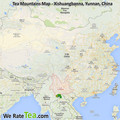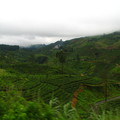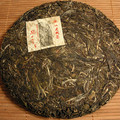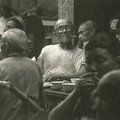Quotes - Shu - Ripe Puerh
„Black Puerh Tea was invented by Kunming Tea Factory in 1972/73 and was manufactured in Xia-Guan Tea Factory ever since 1976. It is now manufactured in many different factories and is by far the most popular type of puerh sold.“

Quotes Tags: Pu-erh, Shu - Ripe Puerh, Tea production, China
„wo dui; 渥 - Wet, 堆 heap/pile - Wo dui - 渥堆, Literally wet -pile The process of 'pile fermentation which is used to make 'aged' Puer tea.“
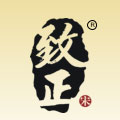
Quotes Tags: Shu - Ripe Puerh, Pu-erh, Tea production, China
„hong; 红 - red. In China, what is called black tea in the English speaking world, is called red. Cooked Puer is sometimes mistakenly referred to as a black tea.“

Quotes Tags: Shu - Ripe Puerh, Red tea, Black tea, Pu-erh, Tea production, China
„cha hu; 茶壶 - Tea pot. Made of porcelain, pottery or glass. Yixing pots are used for both cooked and raw Puer. Since they are pourous, the pots absorb flavours and chemicals from the tea. If one is serious about using Yixing pots, particularly for sheng Puer, one needs to be ready to get at least two pots - one for older and one for younger teas. And these should not be used for brewing other teas, and vice-versa. Yixing teapots will typically soften the flavours of sheng Puer.“

Quotes Tags: Sheng - Raw Puerh, Shu - Ripe Puerh, Tea infusion, China
„Some tea collectors believe "ripened" Sheng Cha should not be aged for more than a decade.“
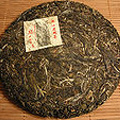
Quotes Tags: Pu-erh, Shu - Ripe Puerh
„This process was first developed in 1972 by Menghai Tea Factory and Kunming Tea Factory] to imitate the flavor and colour of aged raw pu-erh, and was an adaptation of wet storage techniques being used by merchants to falsify the age of their teas. Mass production of ripened pu'er began in 1975. It can be consumed without further aging, though it can also be stored to "air out" some of the less savoury flavors and aromas acquired during fermentation.“

Quotes Tags: Pu-erh, Shu - Ripe Puerh
„Poor control in fermentation/oxidation process can result in bad ripened pu'er, characterized by badly decomposed leaves and an aroma and texture reminiscent of compost.“

Quotes Tags: Pu-erh, Tea oxidation, Shu - Ripe Puerh
„The piling, wetting, and mixing of the piled máochá ensures even fermentation. The bacterial and fungal cultures found in the fermenting piles were found to vary widely from factory to factory throughout Yunnan, consisting of multiple strains of Aspergillus spp., Penicillium spp., yeasts, and a wide range of other microflora. Control over the multiple variables in the ripening process, particularly humidity and the growth of Aspergillus spp., is key in producing ripened pu'er of high quality.“

Quotes Tags: Pu-erh, Yunnan, Shu - Ripe Puerh
„The process used to convert máochá into ripened pu'er is a recent invention that manipulates conditions to approximate the result of the aging process by prolonged bacterial and fungal fermentation in a warm humid environment under controlled conditions, a technique called Wò Dūi (渥堆, "wet piling" in English), which involves piling, dampening, and turning the tea leaves in a manner much akin to composting.“

Quotes Tags: Pu-erh, Shu - Ripe Puerh
„‘Ripened’ Shou Cha (熟茶) tea is pressed maocha that has been specially processed to imitate aged "raw" Sheng Cha tea. Although it is also known as cooked pu-erh, the process does not actually employ cooking to imitate the aging process. The term may come about due to inaccurate translation due to the dual meaning of shú (熟) as both "fully cooked" and "fully ripened".“

Quotes Tags: Pu-erh, Sheng - Raw Puerh, Shu - Ripe Puerh, Maocha
„After picking appropriate tender leaves, the first step in making raw or ripened pu'er is an optional wilting/withering stage, thus converting the leaf to maocha.“

Quotes Tags: Pu-erh, Sheng - Raw Puerh, Shu - Ripe Puerh, Maocha
„Pu-erh is typically made through the following steps:
1. green/raw 青普: sun fixation 曬青 > rolling 揉捻 > sun drying 曬乾:
2. dark/ripe 熟普: sun fixation 曬青 > rolling 揉捻 > Wo Dui (piling) 渥堆 > sun drying 曬乾:
3. added processes: green and dark pu'er can be compressed/shaped into cakes and aged.“

Quotes Tags: Pu-erh, Sheng - Raw Puerh, Shu - Ripe Puerh, Tea production
„Ripened or aged raw pu-erh has occasionally been mistakenly categorised as a subcategory of black tea due to the dark red colour of its leaves and liquor. However, pu-erh in both its ripened and aged forms has undergone secondary oxidization and fermentation caused both by organisms growing in the tea and free-radical oxidation, thus making it a unique type of tea. This divergence in production style not only makes the flavour and texture of pu-erh tea different but also results in a rather different chemical makeup to resulting brewed liquor.“

Quotes Tags: Pu-erh, Tea oxidation, Sheng - Raw Puerh, Shu - Ripe Puerh
„Maocha can be sold directly to market as loose leaf tea, compressed to produce "raw" Sheng Cha, naturally aged and matured for several year before being compressed to also produce "raw" Sheng Cha or undergo Wo Dui ripening for several months prior to being compressed to produce "ripe" Shou Cha.“

Quotes Tags: Pu-erh, Sheng - Raw Puerh, Shu - Ripe Puerh, Maocha
„Pu-erh tea processing, although straightforward, is complicated by the fact that the tea itself falls into two distinct categories: the "raw" Sheng Cha and the "ripe" Shou Cha. All types of pu-erh tea are created from máochá (毛茶), a mostly unoxidized green tea processed from a "large leaf" variety of Camellia sinensis (C. sinensis assamica) found in the mountains of southern Yunnan.“

Quotes Tags: Pu-erh, Tea oxidation, Yunnan, Sheng - Raw Puerh, Shu - Ripe Puerh
„Wo Dui - this new process produced a finished product in a manner of months that many thought tasted similar to teas aged naturally for 10–15 years and so this period saw a demand-driven boom in the production of Hei Cha by the artificial ripening method. “

Quotes Tags: Pu-erh, Shu - Ripe Puerh
„The recently developed Wo Dui process (渥堆) pioneered by both the Menghai and Kunming Tea Factories has created a new type of pu-erh tea of which some traditionalists dispute the legitimacy. This process involves an accelerated fermentation into "ripe" Shou Cha (熟茶) which is then sold loose or pressed in various shapes.“

Quotes Tags: Pu-erh, Shu - Ripe Puerh
Teas
2012 Yunnan Sourcing "Qiu Yun" Wild Arbor Raw
 1 review
1 reviewLate autumn harvest tea from wild arbor tea trees (between 60 and 80 year old) growing in the area of Yi Bi...
2014 Yunnan "Bai Mu Dan" White Tea
 1 review
1 reviewFujain famous white tea "White peony" (Bai Mu Dan)- Taste similar but not the same. This tea come from tea...
Sheng 2013 Blind Tasting Set
 1 review
1 reviewBuy only teas you like not teas you think you like! This is a blind tasting set of all pu-erh.sk spring...
Theme
Tea by region
We will help you with tea selection.
Do you like quality loose tea?
We will help you to find the right one for you. Be inspired by tea ratings of other tea lovers. Rating stars could help you.


Review your cup of tea.
Review the tea you are drinking and help other tea lovers to find the right cup of tea.



Quotes
„Tea consumption has its legendary origins in China of more than 4,000 years ago.“



 Shops
Shops Share on Facebook
Share on Facebook






